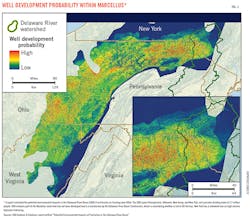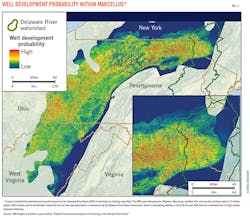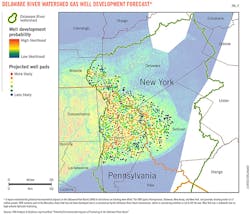Study estimates impacts if DRB, New York fracing bans were lifted
A nonpartisan analysis group estimates up to 4,000 more Marcellus natural gas wells on 500-1,000 pads could be drilled in the Delaware River Basin (DRB) if hydraulic fracturing moratoriums were lifted.
Some industry observers quickly noted the report was based on 4,000-ft laterals and 500 ft of spacing while companies actually are using longer laterals and spacing of 600 ft or more.
In a lengthy report released during August, the nonprofit CNA Analysis & Solutions of Arlington, Va., forecast potential new wells that might be drilled in eastern Pennsylvania and southern New York.
Research done for the report was financed by Delaware Riverkeeper Network, which has called for a permanent ban on gas development in the watershed.
The study focused on DRB locations where Marcellus development reasonably could be expected and did not consider other shale formations in the region.
The DRB spans Pennsylvania, Delaware, New Jersey, and New York. It contains part of the Marcellus shale where fracturing is halted under a moratorium by the DRB Commission.
Separately, the state of New York has banned hydraulic fracturing.
"For this reason, the DRB is a good candidate for a prospective analysis of potential impacts," the study said. Researchers combined geospatial analysis and statistical modeling to create a probability surface area from which to forecast locations for future wells based on existing wells.
Using the probability surface and an estimate of the number of wells that would be needed to fully develop the shale play, researchers estimated the future landscape of development (see maps).
Paul Faeth, director of CNA's Energy, Water, and Climate division and co-author of the report, said it provides information to help understand potential fracing impacts within the basin before they occur. "We were surprised by some of the results," he noted.
The report's coauthors were Steven Habicht and Lars Hanson.
The report concluded:
• Total DRB acreage that could be disturbed by the additional fracing would be 18-26 sq miles.
• Development of well pads and rights-of-way for gathering lines and roads could disturb 17-23 acres per pad. An estimated 75% of the impact would come from gathering lines.
• Water withdrawals during periods of maximum well development could range from 70% from small streams during low-flow conditions to less than 3% during normal flow periods.
• Installation of multiple compressor stations to support additional gas development could as much as double nitrogen oxide emissions in affected counties.
• Roughly 45,000 people live within 1 mile of projected well pad sites, a distance the report said scientific literature has related to health risk factors. This population is predominantly in Wayne County, Pa.
Projected wells, infrastructure would change landscape
"If natural gas development occurs as projected, infrastructure will become a widespread and prominent feature of the landscape in the Upper DRB," the report concluded. "At a basic level, drilling rigs and truck traffic will have temporary effects near any one well pad, but over a long build-out, they could become common within the basin."
It said well pads, roads, and pipelines would most likely be long-term (30 years or more) or, in some case, permanent features of the landscape. "Similarly, management of water, wastewater, and air emissions can create both short- and long-term impacts to the region," it added.
CNA researchers used the Energy Information Administration's estimate of nearly 114 tcf of technically recoverable resources for the Interior Marcellus and EIA's estimated ultimate recovery estimates.
"We subtracted the number of existing Marcellus wells from this total to get the number of new wells expected, which is over 63,000," the report's authors wrote. "We then developed two scenarios to model how well pads may be developed throughout the region to accommodate these new wells."
The report outlined scenarios using development of four wells per pad (dispered) and development of eight wells per pad (concentrated.)
The dispersed scenario envisioned 63,412 new wells and 15,853 well pads on 367 acres while the concentrated scenario envisioned the same number of wells on 7,926 well pads and 735 acres.
Authors assumed a 4,000-ft lateral and 500-ft spacing between laterals. They forecast 74% of potential future development in Pennsylvania.
But Range Resources Corp. of Fort Worth, Tex., has discussed using 5,200-ft laterals in the Marcellus while Cabot Oil & Gas Corp. of Houston has said it uses 5,300-ft laterals.


